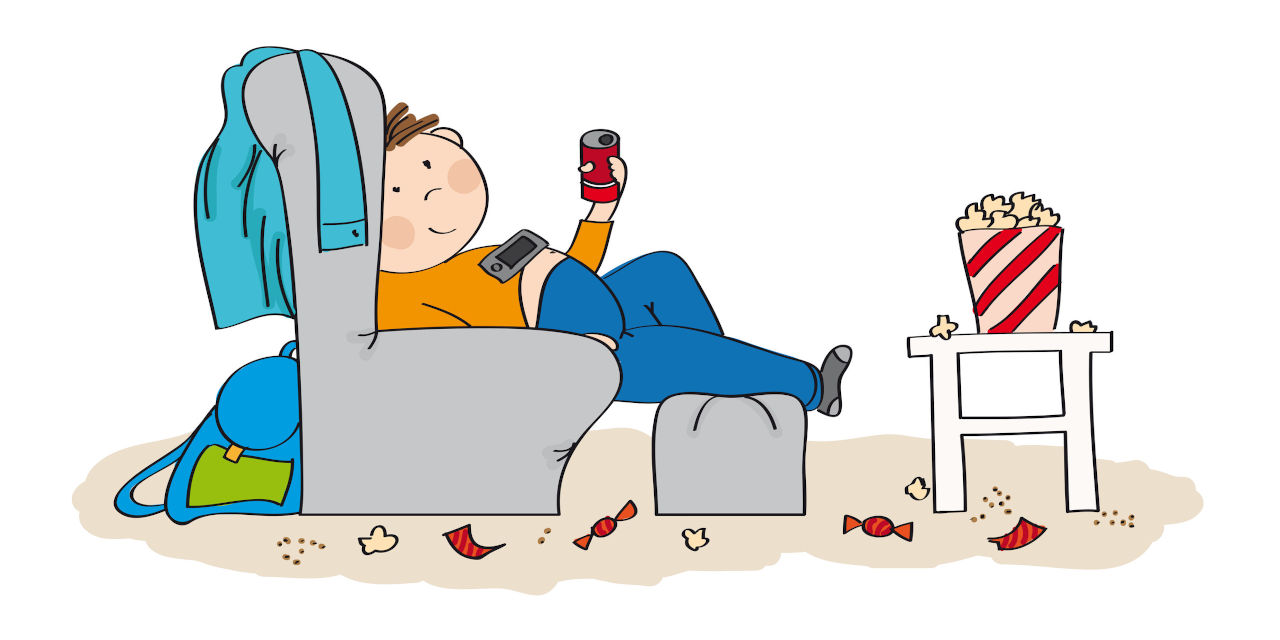By Sue Paul
When I was a young girl, I used to sit on a scratchy braided rug at the foot of my grandmother’s recliner chair and watch Sesame Street while she read the paper, clipped coupons, or opened cards and letters. There was a rickety folding TV tray stacked with mail and magazines on her left. And a wooden end table on her right where a lamp, a rotary phone, a box of gingersnaps, and a glass of Pepsi competed for real estate. Wedged between her hips and the sides of the chair was a treasure-trove of hidden gems. There might be a letter opener, a sweater, a box of tissues, two or three sleeves of Life Savers, an old Reader’s Digest, and remnants of the aforementioned gingersnaps ground into the worn fabric.
While my grandmother was an extraordinarily sweet and generous woman, that chair was exclusively hers — her throne, her perch, her domain. She kept everything she needed within arm’s reach. Although I never drew the parallels then, her chair wasn’t unlike the home of the beloved Sesame Street character Big Bird and his oversized nest — the place from which he entertained visitors, surrounded by his things, and spent the majority of his time.
The Nest
I’ve seen this phenomenon of “the Nest” in literally hundreds of homes I’ve visited while providing occupational therapy services to the aging, sick, and cognitively impaired. In a practical sense, it is both efficient and safe to keep frequently used items nearby. And it is hard to fall if you rarely stand. But in regard to overall health and cognitive optimization, the lack of movement and disorganized environment can impede performance over the long term … especially in the presence of cognitive impairment.
The Five Zones of Function
For someone living at home with dementia or mild cognitive impairment, the environment can play a critical role in promoting cognition and function. The variety of tasks the average person does throughout the day can require a range of specific cognitive and physical skills. The tendency of many people is to centralize operations “Big Bird style” from a recliner chair or bed, usually with the television as a constant companion.
In the presence of cognitive decline, this is a flawed approach.
Breaking the habit of the Nest can be a challenge. While preventing the accumulation of “stuff” around a favorite surface is usually the best strategy, many are resistant. Nests develop out of necessity (mobility limitations or pain) or from lack of attention, motivation, or organizational skills. Structuring the home environment by function promotes both physical movement and cognitive efficiencies. We do this by setting up the home in workstations dedicated to specific functions.
Zone 1: The Nutrition Zone
The primary objective of the Nutrition Zone is to fulfill nutrition requirements in a healthy, habitual, and humanistic way. This requires intention and attention —– skills that may be lacking in someone with cognitive impairment. Here are a few suggestions:
- Set up a Nutrition Zone at a table with a solid chair. Upright sitting promotes core strength and digestion.
- If possible, the atmosphere should be bright and engaging.
- All meals should be eaten at the table. Resist the urge to eat in front of the television or in the Nest.
- Use color contrast to promote attention to food. Potatoes on a beige plate are harder to attend to than dark green vegetables on a white plate or scrambled eggs on a red plate.
- Walking to the table three or four times a day promotes mobility, strength, and balance.
- Because mealtime has always been a communal activity among humans, try to have the person sit with others during meals. If the person must eat alone, place a few photos of family members around the table.
- Clear the table of clutter and other “activities” like mail and magazines. The table should be exclusively for eating.
- Hydration is equally important. A water bottle or pitcher of water left on the table can be a great reminder to drink.
- Sometimes it makes sense to include medications in the Nutrition Zone, as many need to be taken with food. In this case, use a pillbox or medication organizer to promote correct frequency/dosage and to decrease the need for multiple medication bottles that may clutter the table.
Zone 2: The Self-Care Zone
The Self-Care Zone can consist of one or two locations where bathing, dressing, toileting, and grooming take place. One of these spots may be in the bathroom, and the other in the bedroom.
- Keep the Self-Care Zone free of excess items, and set it up for task efficiency.
- The toilet, sink, and shower should be set up for safety (grab bars, nonslip surfaces) and have only the items necessary for task completion nearby.
- The shower can have a washcloth, soap, and one bottle of shampoo and/or conditioner.
- Towels should be of a contrasting color to the wall and floors and within reach of both the shower and sink.
- The sink should have the items for oral hygiene in plain sight and a single comb or brush. Skin care items, perfumes, shaving equipment, etc. should be kept to necessities only and set out in plain sight.
- Putting items in cabinets and drawers makes it harder for someone with mild cognitive impairment or dementia to stay on task. Therefore, keeping necessary items in plain view promotes attention, memory, and task completion.
- A toilet lid of a contrasting color (blue seat on a white bowl) can facilitate safer transfers. Also, colored toilet bowl water may help promote “aim” for men who sometimes miss the bowl when urinating.
- Self-care in the bedroom can be promoted by establishing a workstation specifically for dressing.
- Having a solid-surface chair, with arms, if needed, is preferable to sitting on the edge of the bed.
- Clothing, shoes, and adaptive aids should be accessible from the chair. This may require setup by the person or a caregiver prior to initiating dressing.
- Keep the space around the chair free from obstacles. This spot has the potential to become a secondary “nest” if not maintained.
Zone 3: The Life Management Zone
It is important for people with cognitive impairment to stay engaged in their own routines, schedules, and financial matters. Even if these activities require caregiver oversight, promoting engagement and attention to the daily, weekly, and monthly activities is helpful for promoting cognition and self-agency. This is best achieved by designing an office environment for organizational efficiencies.
- The Life Management Zone does not need to be an actual room or office. It can be a small space with a table or desk. All paper should go in this zone.
- The Life Management Zone is the place where mail and paperwork are sorted and either trashed or saved. All you need are a few labeled bins and a trashcan.
- A large desk calendar can help with orientation and scheduling.
- Connection to others is an important life skill. Promote letter writing, email, and/or video calling from this space as well. A phone at this location is also helpful for scheduling and personal connection.
- Lighting is important. Direct light on a work surface facilitates attention and processing.
- Remember that successful completion of a challenging task like paying a bill or balancing a checkbook is not the goal of the workspace. It is an opportunity to participate in a lifelong activity and practice cognitive skills in an organized, task-appropriate environment.
Zone 4: The Exercise Zone
Although most people are aware that exercise and movement are important, many people still struggle to make exercise a part of their daily life. Trying to incorporate exercise into a “nest” situation forces the idea to compete with other more desirable activities like snacking or reading. Success with exercise programming is best accomplished in a designated space designed for success.
- Many people already have a piece of exercise equipment in their home. Dust off that treadmill or bike, and create an active space for movement.
- A chair and a surface to facilitate standing (table, countertop, grab bar) are ideal for the exercise station. The kitchen sink can be a great location.
- Keep equipment (dumbbells, resistance bands) above knee level in a box or bin.
- Written exercise programs should be on hand, or in some cases, an accessible television, tablet, or laptop with fitness videos can provide a great resource.
Zone 5: The Calm Zone
Environmental design can alleviate many issues that arise in the presence of cognitive decline. These issues may include stress, anxiety, and sleep disturbance. Having a place separate from more engaging functions to meditate, rest, and sleep is important to restore balance and a sense of calm. This should be the go-to place for relaxation and respite.
- The bedroom is a great location for establishing a sense of calm. Relaxing colors and soft surfaces can help promote rest and tranquility.
- Decorate with highly familiar, comforting photos, pictures, and memorabilia, but keep clutter to a minimum.
- If at all possible, sleep in a bed. The brain and body can learn to associate the bed with sleep and workstations with activity.
- Weighted blankets are great sources of comfort for some. The proprioceptive input can be very soothing.
- Although recliner chairs can be comfortable and convenient, prolonged positioning in a flexed posture (bent spine, hips, knees) is not good for the body. Extending joints and soft tissue in a full-body stretch on a bed is important for orthopedic health.
- Music, white noise, or nature sounds in this space can be helpful for sleep and restoration.
Implementation
Establishing five Zones of Function is possible in any size space. I have designed functional zones in one-room studios and assisted living apartments; shared living environments; and large, spacious homes where too much space was actually a problem. Cognitive decline does not need to be synonymous with functional decline. Maximizing the environment to streamline processes is a proven way to promote independence, safety, and function.
A Note About Memory Impairment
Relying on declarative memory to learn a new process is not always feasible in the presence of cognitive decline due to neurodegeneration (Alzheimer’s, Parkinson’s, etc.).
There is a chance that new processes and procedures in the home may not be readily adopted, due to memory and executive function deficits. This is where motor memory comes into play. Home modifications and new activity methods can be learned by doing … practice, practice, practice.
Allow three to six weeks (or longer) of repetitive, guided use of the zones to become ingrained in the brain and habituated. Nesting tendencies may continue but be reduced through consistent maintenance and promotion of the new workstations.
The goal is a more mobile, more nourished, more engaged, and more functionally successful person who lives life in every corner of their home … not just from The Nest.







